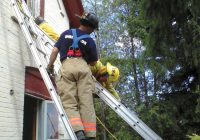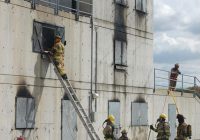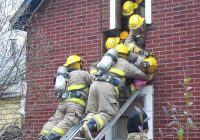
We introduced our topic of ladder dating — coined such because you need to know your ladder intimately and would do well to date it first — in the February edition of Fire Fighting in Canada, and we’re going to dive right in here by detailing climbing angles. There are a few opinions on what the proper angle is for setting up a ladder so it’s safe to climb. Some of the arguments are valid and others are not.
In basic training, we instruct from the textbook that the optimal climbing angle for any ladder, be it a ground ladder or an aerial device, is 75 degrees or ¼ of the building height. This optimal angle allows for a firefighter to ascend and descend the ladder with ease. They should be able to stand upright while climbing just as they would be if they were walking on level ground. It is designed to remove some of the physical stress and exertion from the firefighter, thus making the task assigned a little bit easier.
How do we measure the climbing angle of 75 degrees or ¼ of the building height? Every ground ladder will have a pictorial diagram on the beam side of it showing how a firefighter can measure with their arms out extended, their feet planted at the base tip of the ladder and their hands just touching the rung of the ladder in front of them. If a firefighter can do this, then the ladder is at the optimal climbing angle. Other ladders will have an “L” on an angle so that when the ladder is set to the proper angle, the “L” will read just like you see it here —level.
With the ground ladder angle set, is it really at 75 degrees or ¼ of the building height? How do we know if it is or not? How many of you carry a protractor in your coat pocket so, when you’re setting up a ladder, you can pull it out and measure the angle to ensure it is at 75 degrees? Or carry a laser device to measure the height of the building so that you can deduce what length out from the wall the ladder should be at to be ¼ of the building height? The answer is obvious – no one carries these items.
But what if the ladder is not at the optimal climbing angle? Will the ladder not work properly if it is set at an angle of 65 degrees, 55 degrees, or 60 degrees? If you look at Photo 1, you will see two ground ladders set at different angles. One is at the optimal climbing angle of 70 to 75 degrees and the other is slanted at an angle that is probably around 50 degrees. In this photo, both ground ladders are going to provide what is needed at both climbing angles. The one ladder is not superior over the other in terms of holding the firefighter’s weight, providing ingress and egress from the building, allowing the firefighter to work off the ladder, and so on.
How is this possible? The ground ladder is tested annually to ensure that it meets weight and performance limitations. When it is tested, the ladder is placed horizontally, resting on two separate work horses or end supports. Then there is a 500-pound weight that is placed in the middle of the ladder, which is then suspended off the ground for five minutes. The pawls or locks or dogs are then tested to 1,000 pounds to make sure they will not fail under load. If a ground ladder can withstand these types of weights on a horizontal plane, will the same ladder not also withstand our normal operations at an angle less than 75 degrees? Yes, it will.
In Photo 1, the ladder that is set at a lower angle has a firefighter doing a headfirst ladder dive, so it would make sense to have a ladder set at an angle that is not so steep. But in Photos 2 and 3, you will see examples of firefighters standing or working off the ladder to perform a rescue or other functions. Both photos show the ground ladder set at an angle less than 75 degrees, and the firefighter(s) having no problem working off of them.
So, why should we not care too much about setting the ground ladder at the optimal climbing angle every time? The short answer is time. Time is always against us when we need to perform a rescue at a structure fire and taking the time to measure the ladder once set is taking away the time needed to perform the rescue.
Other reasons why we do not want to always set the ladder at 75 degrees is for the firefighter’s benefit. One reason is for firefighter survival or egress methods. If a firefighter needs to get out of the building quickly by doing a head first ladder dive or get onto the ground ladder quickly to climb down, the angle it is set at will accommodate a less intrusive descent.
A second reason is for firefighter rescue as shown in Photo 3. It is easier to remove a downed firefighter from a building down a ladder at an angle that is less intrusive. Also, when we are removing an occupant from the building down the ladder, it is easier for us to control the occupant if they are unconscious, lying horizontally across our arms down a ladder that is less intrusive than at an angle that is at 75 degrees.
Do not get to hung up on setting the ground ladder at the optimal climbing angle whenever using at a structure fire or other instances where the ladder is needed – you will find that the ground ladder set at 60, 65, or 55 degrees will work just as well as safely as a ladder set at 75 degrees.
Mark van der Feyst has been a member of the fire service since 1999 and is a full-time firefighter in Ontario. Mark teaches in Canada, United States and India, and is an FDIC Instructor. He is the lead author of the Residential Fire Rescue book. Email Mark at Mark@FireStarTraining.com.
Print this page


